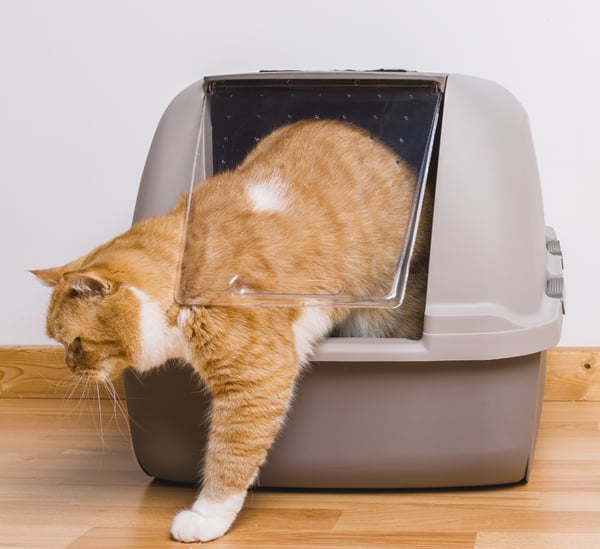The Essentials of Litter Box Training
Poor litter training can lead to behavioural problems on a daily basis. This means more work for you. Know the essentials to have an easier training time!
BEHAVIOR AND TRAINING NEW BEGINNINGS
4 min read
Litter box training a cat should be a breeze because her mother would've taught her how to use the litter tray. However, it's still good to know the essentials to ensure that your furkid knows where to do her business and lower the chances of behavioural problems.
Here are the Four Essentials of Litter Box Training.


#1 Get the right Litter Box
You'll need to experiment to see what kind of litter box your cat prefers. As a start, a conventional open box is good. It's simple and cost-effective, but there's not much odour control and litter gets everywhere.
For a kitten, make sure the litter box is low enough for her to climb in and out with ease. You might need to get a lower one then transition to a regular height box.
After your kitty gets used to an open litter box, you can try other types such as enclosed litter boxes. Some cats do not like enclosed litter boxes as it's confining and restricting. If you do get one, there are a few things to take note of.
First, the internal space needs to be big enough for your cat. Second, if there is a door, make sure it is at the right height so your cat won't have to bend down or climb up to enter.
Only consider the enclosed litter boxes with a ceiling entrance if your cat is still young with no mobility issues. These types can get difficult for senior or phsycially hindered cats.
Check out the Choosing the Best Litter Box Guide for more help.
If you have more than one cat, the rule of thumb is to have at least one litter box per cat, plus one additional spare one.
#2 Find a Desirable Litter
Some cats are picky about the kind of litter to do their business in. It might not have a desirable texture, consistency, size, smell—and the list goes on. Who said cats were easygoing?
The highest chances of successful matchmaking is a litter that's like sand, small granules, and unscented—similar to the dirt they would use in the wild.
You can first try your preferred litter to see if your cat will use it. If she doesn't, use the suggested type above, and when litter box training is over, slowly transition to your choice.
A slow transition is about gradually mixing a greater proportion of the new litter with the old one until it's all new litter. You can start out a proportion of—80% old and 20% new—for three to sex days. Then, 50% old and 50% new, and so on.
We recommend choosing a litter that is digestible and not harmful to your cat. Features like biodegradable, low-tracking or dust-free (fewer fine particles to be inhaled by both your cat and you), and natural or non-toxic.
Your cat will be around the litter on a daily basis and she'll inevitably swallow it by accident or on purpose. It's better to have a harmless and edible litter for your kitty's good health.
#3 Location, Location, Location!
The prime spot for your cat's litter tray is in a quiet, secluded, low-traffic zone. Preferably not near the food and water area as well, because cats don't like to eat where they poop. They're most likely more hygienic than your husband/boyfriend/father/brother/guy pal (sorry men!).
During the early stages of litter box training, a perfect location might be the spare bathroom or somewhere your cat will not be disturbed while using the litter box.
Some cats are very open to using the toilet whenever, and wherever, while others like privacy. More private cats don't like to be watched as it makes them uncomfortable—so try to give kitty her space when doing the deed.
Once you've found a spot, bring your cat to the litter box to show her where it is. Try not to move it until she's aced litter box training with no problems.
#4 Praise the Good, Correct the Mistakes
Whenever your cat uses the toilet correctly, throw out the praises and treats. Positive reinforcements work best with cats and you'll want her to associate using the litter tray with good memories. Eventually, she won't need you to reward her and you can gradually cut back.
When your cat looks like she's about to go, but she isn't at her litter tray, bring her to it—hopefully, you'll make it in time!
If she does go elsewhere besides the litter tray, bring her to the accident and firmly say "NO!", then show her the litter tray again. If you can stomach it, transport her business as well to the litter tray and puppeteer her to bury the faeces.
In the beginning, when cleaning the litter box, don't change all the litter. Leave about 5% of the old behind so the toilet scent is still strong until your cat has no blunders.
If she keeps going at a particular spot in the house, consider shifting her litter box there. That location might be more to her liking than what you've picked. Slowly when she's trained, you can try shifting it to wherever you want.
Following these Essentials of Litter Box Training, your kitty will be the most wanted drizzling and pooping machine!
Liked this guide?
Share with others!
Don't miss out!


Sign up for our newsletter to get 10% OFF your first order, the latest deals, kitty escapades, and useful tips.
© Raw Munch Pte Ltd. All rights reserved. | Sitemap | Privacy Policy | Terms and Conditions
Monday to Sunday: 11am to 8pm
